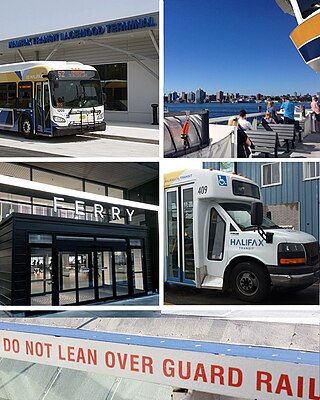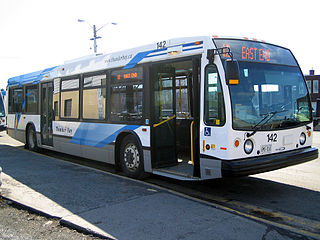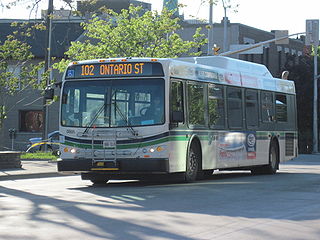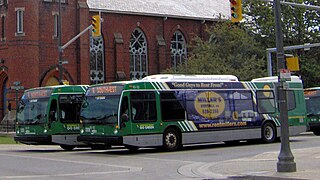
A trolleybus is an electric bus that draws power from dual overhead wires using spring-loaded trolley poles. Two wires, and two trolley poles, are required to complete the electrical circuit. This differs from a tram or streetcar, which normally uses the track as the return path, needing only one wire and one pole. They are also distinct from other kinds of electric buses, which usually rely on batteries. Power is most commonly supplied as 600-volt direct current, but there are exceptions.

The Hamilton Street Railway (HSR) is the public transport agency for Hamilton, Ontario. The name is a legacy of the company's early period, when public transit in Hamilton was primarily served by streetcars. Although streetcars are no longer used in the city today, the HSR operates bus and paratransit services, with a ridership of 21 million passengers a year.

Paratransit or intermediate public transport, is a type of transportation services that supplement fixed-route mass transit by providing individualized rides without fixed routes or timetables. Paratransit services may vary considerably on the degree of flexibility they provide their customers. At their simplest they may consist of a taxi or small bus that will run along a more or less defined route and then stop to pick up or discharge passengers on request. At the other end of the spectrum—fully demand-responsive transport—the most flexible paratransit systems offer on-demand call-up door-to-door service from any origin to any destination in a service area. In addition to public transit agencies, paratransit services may be operated by community groups or not-for-profit organizations, and for-profit private companies or operators.

The Toronto Transit Commission (TTC) uses buses and other vehicles for public transportation. In 2018, the TTC bus system had 159 bus routes carrying over 264 million riders over 6,686 kilometres (4,154 mi) of routes with buses travelling 143 million kilometres in the year. As of 2021, the TTC has 192 bus routes in operation, including 28 night bus routes. In 2023, the system had a ridership of 362,041,400, or about 1,240,300 per weekday as of the second quarter of 2024.

The Société de transport de Montréal is a public transport agency that operates transit bus and rapid transit services in the urban agglomeration of Montreal, Quebec, Canada. Established in 1861 as the "Montreal City Passenger Railway Company", it has grown to comprise four subway lines with a total of 68 stations, as well as 212 bus routes and 23 night routes. The STM was created in 2002 to replace the Société de transport de la communauté urbaine de Montréal. The STM operates the most heavily used urban mass transit system in Canada, and one of the most heavily used rapid transit systems in North America. As of 2019, the average daily ridership is 2,297,600 passengers: 977,400 by bus, 1,306,500 by rapid transit and 13,700 by paratransit service.

The Boston-area trolleybus system formed part of the public transportation network serving Greater Boston in the U.S. state of Massachusetts. It opened on April 11, 1936, with a large network operating for the next quarter-century. Measured by fleet size, the Boston-area system was the second-largest trolleybus system in the United States at its peak, with only the Chicago system having more trolleybuses than Boston's 463. After 1963, the only remaining portion was a four-route cluster operating from the Harvard bus tunnel at Harvard station, running through Cambridge, Belmont, and Watertown. The Massachusetts Bay Transportation Authority took over the routes in 1964.

Halifax Transit is a Canadian public transport service operating buses and ferries in Halifax, Nova Scotia. Founded as Metro Transit in March 1981, the agency runs two ferry routes, 66 conventional bus routes, three regional express routes, and three rural routes. Halifax Transit also operates Access-a-Bus, a door-to-door paratransit service for senior and disabled citizens.

Guided Light Transit was the name of guided bus technology and associated infrastructure designed and manufactured by Bombardier Transportation. It was installed in two French cities: Nancy and Caen. The Caen system was closed in 2017 and replaced by conventional trams, while the Nancy system was closed in March 2023 and is to be replaced by trolleybuses.

Thunder Bay Transit is the public transit operator in Thunder Bay, Ontario, Canada. It was formed in 1970, after the amalgamation of the cities of Port Arthur and Fort William and their respective transit agencies. Thunder Bay Transit is a member of the Canadian Urban Transit Association.

The Caen guided light transit or Caen TVR, locally known as "the Tram", was an electrically powered guided bus system in Caen, France, which used Bombardier Guided Light Transit technology.

Marpole Loop is a public transit exchange in the Marpole neighbourhood of Vancouver, British Columbia, Canada. This facility is part of Metro Vancouver's TransLink transit network. Located at the northern foot of the Arthur Laing Bridge, this is the southernmost exchange within the city of Vancouver.

Saskatoon Transit is the public transport arm of the City of Saskatoon, Saskatchewan, Canada. It operates a fleet of diesel buses. A total of 23 bus routes serve every area of the city, carrying approximately 11 million passengers in 2008. Saskatoon Transit is a member of the Canadian Urban Transit Association. The major bus terminal is located Downtown.

St. Catharines Transit (SCT) was a public transit agency which provided bus services to St. Catharines, Ontario, and the neighbouring city of Thorold. The St. Catharines Transit Commission took over operation of transit services within the city from Canadian National Transportation in 1961. In January 2023, St. Catharines Transit was merged with Niagara Falls Transit, Welland Transit, and Fort Erie Transit to form a single regional transit service, Niagara Region Transit.

Woodstock Transit is operated by the City of Woodstock, Ontario, Canada, providing both regular transit bus routes and specialized paratransit services for the community.

The Vancouver trolley bus system forms part of the TransLink public transport network serving Metro Vancouver in the Canadian province of British Columbia. Opened in 1948, the system was originally owned and operated by the British Columbia Electric Railway. By 1954, Vancouver had the largest trolley bus fleet in Canada, with 327 units, and the fleet grew to an all-time peak of 352 in early 1957. There were 19 routes by 1955 and a peak of 20 by the second quarter of 1957. The last route to open in the 1950s was the only express trolley bus service that ever existed in Canada. Several, mostly short, extensions to the system were constructed in the 1980s and later.
Prior to 1959, Montreal, Quebec, Canada had an extensive streetcar system. The streetcar network had its beginnings with the horsecar era of the Montreal City Passenger Railway in 1861. The initial line was along Rue Notre Dame from Rue du Havre to Rue McGill.
As of 2019, King County Metro operates the seventh largest fleet of buses in the United States, with a total of 1,583 buses. The agency's buses traveled a total of 53 million miles (85,000,000 km) and transported over 123 million passengers in 2019.

The Cornwall Street Railway was an electric street railway in Cornwall, Ontario, Canada that operated from 1896 until 1949, and then as a trolleybus service until 1971 when it was replaced by a conventional bus service known as Cornwall Transit. For much of its history, the company was owned by Sun Life Assurance.
The following outline is provided as an overview of and topical guide to public transport:

Simcoe County LINX is a public transport service managed by Simcoe County and operated by First Student Canada, which is responsible for inter-community regional bus service throughout Simcoe County, connecting rural towns and townships to cities in the county such as Barrie and Orillia. Service began in 2018 with a single trial route, operating with a mixed fleet of low-floor midibuses and accessible paratransit vehicles. In August 2019, service was expanded to four routes, five routes in 2020 and six routes in August 2021.


















